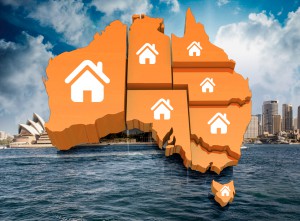There is a lot of noise being bantered about regarding how much money it takes to be rich in Australia. 
And there’s often fuss made about all those rich greedy property investors.
So just how many Australian households hold an investment property?
The Australian Taxation Office recently released their latest stats on property investment, so let’s see how rich property investors really are.
Here is a quick summary…
According to Corelogic:
- There are 10.5 million dwellings in Australia with a total value of $7.1 trillion
- There is a total of $1.85 trillion in outstanding mortgage debt.
- 5% of Australian household wealth is held in housing
The Australian taxation office tells us that in the 2017-8 tax year (the latest statistics available)
- There are 2,207,905 property investors in Australia
- This means around 20% of Australian households hold an investment property and 80% don’t.
- The top investor age groups are:
- 27.83% are aged 60 or more
- 31.67% are aged between 50 and 59 years
- 24.65% are aged between 40 and 49 years
- 14.22% are aged between 30 and 39 years
- Just 1.63% are younger than 30
- Here’s how many properties investors hold
- 1 investment property – 71% (1.57million) – increased by 2.3% over the last year
- 2 investment property – 19% (418,000) – increased by 2.7% over the last year
- 3 investment property – 6% (129,784) – increased by 3 % over the last year
- 4 investment property – 2% (47,469) – increased by 2.2% over the last year
- 5 investment property – 1% (19,861) – increased by 1.8% over the last year
- 6 or more investment property – less than 1% (20,756) – increased by 2% in the last year
How much are these property investors earning?
Nothing much has changed over the years.
The fact that 90% of investors only own one or two investment properties has been the status quo for many years.
But what I find more interesting is digging into the statistics to see you how much rental income these property investors are earning.
Of the 2,207,905 property investors who filed a rental schedule
1. 40% were cash flow neutral or cash flow positive
2. Roughly 60% were in a net rental loss situation (negatively geared)
Here’s a snippet from the ATO data
| No of Property Interests | Overall net rent loss | Overall net rent neutral/profit |
| 2018 | 59.97% | 40.03% |
| 1 interest | 60.02% | 39.98% |
| 2 interests | 60.77% | 39.23% |
| 3 interests | 58.80% | 41.20% |
| 4 interests | 57.51% | 42.49% |
| 5 interests | 56.89% | 43.11% |
| 6 or more interests | 55.95% | 44.05% |
Source: A.T.O.
Some thoughts
Property investment may be simple, but it’s not easy, as clearly most property investors failed to build a sufficiently large property portfolio to provide them with a substantial retirement income.

However, growing a property portfolio will supplement your superannuation and other investment assets to help secure your financial future.
Of course, the number of investment properties you own is not nearly as important as the quality of your assets and amount of equity you have in them.
I’ve often said I’d prefer to own one Westfield shopping centre than 50 properties in regional Australia.
However, you can outperform these averages
Examining these tax office statistics made me wonder how our clients at Metropole Property Strategists, who have been given strategic advice to guide their investing, have performed compared to the average property investor.
Currently, Metropole manages close to $2 billion worth of property assets on behalf of our clients and as you can see form the following chart, on the whole, clients of Metropole have significantly outperformed the averages:
- Only around half of our clients own only one investment property – considerably below the Australian average, but that’s a good thing
- 21% of our clients own two investment properties, and that’s more than the Australian average
- Almost 10% of our clients own three investment properties, almost double the Australian average.
- 6% of our clients own four investment properties, compared to 2% of typical property investors
- 3% of our clients own five investment properties – three times the Australian average.
- 7% of our clients own 6 or more investment properties – more than 7 times the number in the general property investment community.

We’ve only counted the properties we have bought for clients or that we manage for them. This excludes properties clients purchased prior to coming to us, and naturally skews our figures to the conservative side.
It’s easy to buy the first property, but each additional property added is progressively more difficult.
We’d like to think our strategic approach to investing has contributed to our client’s outperformance.
So how do you outperform the averages and grow a multi-million dollar property portfolio?
The first thing is to recognise that not all properties are “investment grade.”
 Of course, any property can become an investment – just kick the owner out and put a tenant in, but that doesn’t make it “investment grade” – one that grows at wealth producing rates of return.
Of course, any property can become an investment – just kick the owner out and put a tenant in, but that doesn’t make it “investment grade” – one that grows at wealth producing rates of return.
The next important factor to recognise is that the location of your property will do 80% of the heavy lifting.
At Metropole we use a Top Down Property Investment Framework – going from the macro to the micro.
The first step it to start with the big picture and find the right locations, ones that will outperform the averages.
With the right location on our radar, we can then begin to drill down and apply the 6 Stranded Strategic Approach to select the right properties within those locations.
This is the property investment system that has helped our clients build a very substantial property portfolio.

Over the years we have honed our strategies to find that less than 4% of properties on the market at any one time that we like to call “investment grade” properties.
We define investment grade, as properties that are likely to grow at wealth producing rates of return.
Let’s look at this framework in more detail. We start with
1. The Right Stage of the Economic Cycle
It starts with buying at the right stage of the economic and property cycle.
We look at the big picture – how is the economy performing and where are we in the property cycle?
2. The Right State
 Then we look for the right state in which to invest – one that is at the right stage of its own property cycle.
Then we look for the right state in which to invest – one that is at the right stage of its own property cycle.
While we are not trying to time the cycle, we do not want to buy right at the peak when we will have to wait longer for capital growth.
We only invest in our larger capital cities, where there are multiple pillars to the economy – because this is where economic growth and wages growth will continually occur.
3. The Right Suburb
Then within that state, we look for the right suburb – one with a long history of strong capital growth outperforming the averages.
We have found some suburbs have 50 to 100 per cent more capital growth than others over a 10-year period and obviously, these are the suburbs we target.
It’s all about demographics, as these suburbs tend to be areas where more owner-occupiers want to live because of lifestyle choices and where the locals will be prepared to, and can afford to pay a premium to live because they have higher disposable incomes.
 In general, they are the more affluent inner- and middle-ring suburbs of our big capital cities, so we will check the census statistics to find suburbs where wages growth is above average.
In general, they are the more affluent inner- and middle-ring suburbs of our big capital cities, so we will check the census statistics to find suburbs where wages growth is above average.
Residents in these areas will have more disposable income to spend on upgrading their homes or buying new properties.
Next, we check out the supply and demand ratio in the area to make sure there is not likely to be a short-term oversupply of properties on the market.
They say things like, “Oh, this suburb hasn’t had much capital growth – maybe it’s time has come,” or, “That’s a brand-new suburb. They’re getting a train line down there so it must grow in value.”
That is a hunch or gut feel and it needs to be backed up with data and a range of important factors, which we will highlight below.
4. The Right Location
Once our research has shown us the suburb to explore, we look for the right location within it.
Some streets will always outperform others and in those streets, some properties will always be more desirable than others and will outperform by increasing in value.
Think about the suburb where you live – there would be areas you would happily live in and areas you would avoid, like on main roads or too close to shops, train lines schools or commercial areas.
5. The Right Property
Once we find the right locations that work, we then use the ‘6-Stranded Strategic Approach’ to find the right property within that location and finally we look for…
6. The Right Price
 We are not looking for a ‘cheap’ property (there will always be cheap properties around in secondary locations).
We are not looking for a ‘cheap’ property (there will always be cheap properties around in secondary locations).
We are looking for the right property at a good price. The right property is the one that will consistently perform year after year.
Interesting, most property investors start with the price and work backwards. The price has to be right but it is not the most important factor when selecting an investment grade asset
Metropole’s 6 – Stranded Strategic Approach
At Metropole, we look for the following strict investment grade fundamentals:
1. Strong Appeal to owner occupiers
Not that you plan to sell your property, but because owner occupiers will buy similar properties thereby pushing up local real estate values.
We also favour locations where a higher number of homeowners live vs investors. This creates more predictability and less volatility and risk.
2. At or below its intrinsic value
That is why we avoid new and off the plan properties, which come at a premium price due to developers margins kickbacks and commissions.
We want to buy below replacement cost / intrinsic value.
3. With a high land to asset value ratio
 That does not necessarily mean a large block of land, but one where the land component makes up a significant part of the asset value.
That does not necessarily mean a large block of land, but one where the land component makes up a significant part of the asset value.
This will be an area where more owner occupiers will want to live because of lifestyle choices and one where the locals will be prepared to, and can afford to, pay a premium price to live because they have higher disposable incomes.
4. A location with a long strong history of capital growth
A known and proven suburb that will continue to outperform the averages because of the demographics in the area.
Following the top down approach which this document covers is how we ensure this.
5. We look for property with a twist
We do not just look for an average property, but we look for something unique, or special, different, or scarce about the property.
Something that sets it apart and gives it a higher level of demand from owner occupiers who are willing to pay more for the property in the right location.
6. Potential to Add value
We buy properties where we can manufacture capital growth through refurbishment, renovations or redevelopment rather than waiting for the market to deliver capital growth. This can be done upon purchase or in the future.
By following Metropole’s 6 Stranded Strategic Approach, we minimise our clients risks and maximise their upside.
Each strand represents a pillar underpinning the capital growth of the property and combining all six is a powerful way of putting the odds in your favour.
If one strand lets you down, you have four or five others supporting your property’s performance.
Now is the time to take action and set yourself for the opportunities that will present themselves as the market moves on

If you’re wondering what will happen to property in 2020–2021 you are not alone.
You can trust the team at Metropole to provide you with direction, guidance and results.
In challenging times like we are currently experiencing you need an advisor who takes a holistic approach to your wealth creation and that’s what you exactly what you get from the multi award winning team at Metropole.
If you’re looking at buying your next home or investment property here’s 4 ways we can help you:
- Strategic property advice. – Allow us to build a Strategic Property Plan for you and your family. Planning is bringing the future into the present so you can do something about it now! This will give you direction, results and more certainty. Click here to learn more
- Buyer’s agency – As Australia’s most trusted buyers’ agents we’ve been involved in over $3Billion worth of transactions creating wealth for our clients and we can do the same for you. Our on the ground teams in Melbourne, Sydney and Brisbane bring you years of experience and perspective – that’s something money just can’t buy. We’ll help you find your next home or an investment grade property. Click here to learn how we can help you.
- Wealth Advisory – We can provide you with strategic tailored financial planning and wealth advice. Click here to learn more about we can help you.
- Property Management – Our stress free property management services help you maximise your property returns. Click here to find out why our clients enjoy a vacancy rate considerably below the market average, our tenants stay an average of 3 years and our properties lease 10 days faster than the market average.
from Property UpdateProperty Update https://propertyupdate.com.au/how-many-australians-own-an-investment-property/
No comments:
Post a Comment